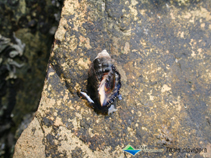Reishia clavigera (Kuster, 1860)
Korean common dogwhelk
Classification / Names Common names | Synonyms | CoL | ITIS | WoRMS
Gastropoda | Neogastropoda | Muricidae
Environment: milieu / climate zone / depth range / distribution range Ecology
Benthic; brackish. Tropical
Distribution Countries | FAO areas | Ecosystems | Occurrences | Introductions
Western Pacific: Southeast and Northeast Asia.
Length at first maturity / Size / Weight / Age
Maturity: Lm 1.7, range 1 - 3.3 cm Max length : 2.7 cm SHL male/unsexed; (Ref. 127116)
Life cycle and mating behavior Maturity | Reproduction | Spawning | Eggs | Fecundity | Larvae
Main reference
References | Coordinator | Collaborators
Blackmore, G. 2001 Interspecific variation in heavy metal body concentrations in Hong Kong marine invertebrates. Environmental Pollution 114:303-311. (Ref. 81522)
IUCN Red List Status
(Ref. 130435: Version 2025-1)
CITES status (Ref. 108899)
CMS (Ref. 116361)
Threat to humans
Human uses
| FishSource |
Tools
More information
Max. ages / sizes
Length-weight rel.
Length-length rel.
Length-frequencies
Mass conversion
Abundance
Internet sources
BHL | BOLD Systems | CISTI | DiscoverLife | FAO(Publication : search) | Fishipedia | GenBank (genome, nucleotide) | GloBI | Gomexsi | Google Books | Google Scholar | Google | PubMed | Tree of Life | Wikipedia (Go, Search) | Zoological Record



